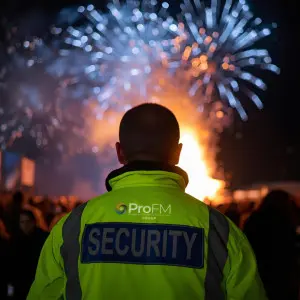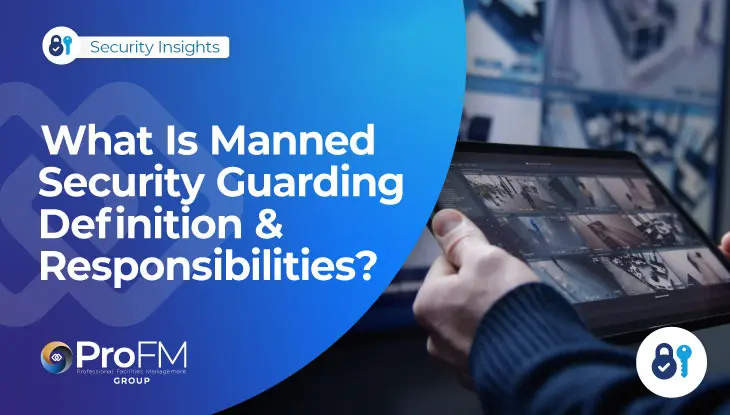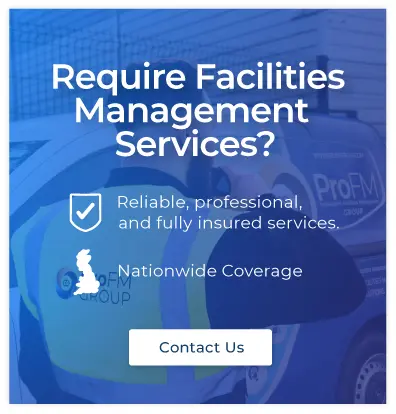Bonfire Night is among the most exciting times of the year, with firework spectaculars and roaring fires illuminating the Autumn evening. However, while it’s a thrilling experience, there’s no underestimating the importance of proper bonfire night safety, especially if you’re planning an event.
Our latest guide provides expert advice on staying safe on Bonfire Night, as well as the best ways to protect yourself, your home, and your business.
Key Tips For Security & Safety On Bonfire Night
It’s essential to maintain a safe and manageable distance from open flames, never return to fireworks once they’ve been lit, and ensure that children and young people are supervised at all times. You should also make sure that any controlled displays (such as shows or large-scale bonfires) are properly cordoned off with barriers, fencing and trained professionals.
That’s just the tip of the iceberg, though, when it comes to how to stay safe on bonfire night. We’ve broken it down into some of the key areas you’ll experience on this chilly November evening, and how you can make this bonfire night safe, secure and fun.

Our Expert Bonfire Safety Advice
Learn how to stay safe on bonfire night around open flames, including large-scale demonstrations and events.
#1 – Keep A Safe Distance From All Flames
One of the most important pieces of advice for bonfire night safety is to keep a safe distance away from any open flames. Even smaller bonfires burn at an estimated 700°C, which is more than hot enough to cause third-degree burns and lasting damage to skin and more sensitive exposed areas like the eyes or nostrils.
Guidance from the Mid & West Wales Fire and Rescue Service places the safe distance at around 15 metres (or approximately 50 feet) away from the fire. We’d agree with that, and the National Fire Chief’s Council (NFCC) actively promote a more cautious approach to bonfires and controlled flame demonstrations, especially those closer to residential areas.
#2 – Avoid Any Areas That Could Have Flammable Materials
It’s crucial to check any area that you plan to use for a bonfire ahead of time. Not only does that help ensure that it’s far enough away from homes and residential areas (Greater Manchester Fire & Rescue places that distance at 18 metres, or 60 feet), but it also means you can avoid any potential fire hazards and ultimately ensure the local area can stay safe on Bonfire Night.
Those could include:
- Dry grass, undergrowth or dead plants (crucial if it’s been a hot summer)
- Sheds, allotments and other outdoor equipment
- Wooden fences, barriers, or panelling
- Overhead cabling, pylons or infrastructure
If you find that the area you plan to use encompasses any of those hazards, do not use that area and replan to find a better staging area.
#3 – Never Use Accelerants Like Petrol Or Methylated Spirits
While it can be tempting to kickstart your bonfire in those early stages, you must not use anything that could accelerate the fire. That could include:
- Petrol, diesel or biofuels – the HSE advises specifically against these
- Paraffin, kerosene and other clean-burning fuels
- Aerosols
- Batteries or electrical items (laptops or mobile phones, for example)
- Methylated spirits (paint stripper, for example)
- Tins of paint or pressurised containers
Not only can this compromise public safety on Bonfire Night, but it can also quickly get out of hand and overwhelm any security professionals or trained fire safety officers on hand to deal with the crowds.
Flash fires, backfires (where petrol vapours spill back onto the person pouring it, setting them alight), and explosions are all possible when using accelerants or prohibited items on your bonfire. The dangers far outweigh any short-term excitement and jeopardise any bonfire night rules you have in place to keep people safe.
#4 – Set Up Barriers To Keep People Moving & Safe
Often overlooked in any planning stage, a key consideration for health and safety on Bonfire Night is how you cordon off your bonfire or displays. While you’d hope that people would keep a safe distance, that doesn’t always prove to be the case, with an estimated 2,000 people every year attending A&E due to injuries sustained on Bonfire Night.
We’d strongly advise investing in comprehensive fencing and lighting solutions as a great way to protect your attendees, maintain compliance, and ultimately ensure a repeat event. It’ll also mean that guests can safely exit, and that you’re able to clear up and move on with minimal fuss.
#5 – Extinguish The Flames Safely With Water
All bonfires should use organic material as their primary fuel, such as timber, kindling, or proper firelighters. This not only means they burn safely and in a controlled manner, but also that they can be extinguished properly with minimal damage to the environment.
This is done with water once the bonfire itself has burnt down to embers. Pour a large amount of cool water onto the remains of the fire, which keeps the area cold, moistened and removes any possible lingering sources of ignition.
Fireworks & Sparkler Safety Advice
While bonfire safety is one aspect of staying safe on Bonfire Night, it’s not the only attraction – fireworks and sparklers also have their own place on the night. They’ve also got their own set of safety tips associated with them.
#6 – Choose The Right Fireworks For Your Event
One of the most important aspects to consider, especially if you’re hosting a private event on your property, is the different classifications of fireworks on the market. For the vast majority of readers, you’ll need a Category F2 or F3 firework, which will be clearly identified on the label.
Here’s a look at what that means:
- F2 Fireworks are the lower-power of the two, meaning they’re better if you’re concerned about Bonfire Night safety. They’ll usually contain less than 500g of gunpowder and will require you to move at least 8 metres away from them after lighting the fuse. Spectators are recommended to be around 15 metres away, with only the person lighting the firework required to be closer.
- F3 Fireworks will usually be more powerful, containing more than 500g of gunpowder, and requiring a stricter distance for both the fuse-lighter (up to around 15 metres) and spectators (a minimum of 25 metres).
There are 4 different categories of fireworks; however, F2 and F3 are the most commonly purchased for Bonfire Night, Diwali or New Year’s celebrations. Outside of that, there are:
- F1 Fireworks, which are most commonly suited to indoor displays. They’ll have minimal gunpowder, and would be advised if you’re worrying about Bonfire Night safety for younger children or vulnerable people.
- F4 Fireworks are the most powerful options, and cannot be purchased without an official licence for firework displays. These are what you’ll see if you visit a professionally-coordinated fireworks display, or attend an official event that uses fireworks (such as part of a festival or concert).
Outside of that, sparklers and other small fireworks are recommended to be used safely, but don’t have specific directions outside of what the packaging says.
#7 – Avoid Purchasing Your Fireworks From An Unregulated Seller
If you’re concerned about Bonfire Night security and safety, one of the most important pieces of advice we can give you is to ensure that you buy your fireworks (and any associated equipment) from an accredited and licensed seller. All supermarkets will have a licence, as will registered fireworks sellers.
If you’re unsure, we’d advise asking to see the seller’s licence before buying anything. A good seller will usually have this displayed, but if they don’t, asking is a great place to start. You should also check the packaging of any fireworks you plan to buy.
They should carry a “CE” mark, which, according to Mid & West Wales Fire & Rescue, is the mark of compliant fireworks, sparklers and other display equipment (like Roman Candles or Catherine Wheels). It’s essentially an indicator that you’re purchasing a properly regulated product.
Always read the instructions on the packaging (a basic of bonfire safety, but one that bears repeating). This will give you strict guidance on safe distances, spectator distance, and the level of firework you have. This should only be F1, F2 or F3 – do not buy fireworks that are marked as F4 unless you have the right training and licensing to do so safely.
#8 – Light Your Fireworks Safely & Do Not Return
All licensed fireworks will have full instructions on how to handle and light your equipment. These will be located on the back of the packaging or (if you’re purchasing larger rockets) on the firework itself. You should follow these instructions carefully – it’s a crucial element of safety on Bonfire Night or other celebrations.
For example, if you’re lighting an F2 Firework (best suited to larger gardens or small-scale gatherings), you’ll have two figures:
- The “Retire Immediately” distance. This is the distance you should move back if you’re the one lighting the firework. For an F2 Firework, this is usually between 8 and 15 metres.
- The “Safe Spectator” distance. This is the distance your spectators (family, friends, audience, etc.) should stand from the firework to stay safe on your Bonfire Night display. It’ll usually be between 15 and 25 metres.
It may seem simple, but you should not return to the firework until after it has launched and the area is clear of smoke and any debris. Even if it seems like it has malfunctioned, there is still a danger that it can detonate, causing severe burns, hearing loss, and even the loss of limbs.
Wait a minimum of 20 minutes before cautiously approaching the firework, then move it carefully into a bucket of cold water. According to East Sussex Fire & Rescue, it should stay there for several hours, after which time the firework will be inert (meaning it can no longer detonate) and can be disposed of properly in the bin.
#9 – Direct All Fireworks Away From Spectators
This should go without saying, especially in a guide to Bonfire Night safety tips, but with thousands of A&E admissions every year attributed to firework-related injuries, it’s a tip that can’t be overlooked.
For anyone who’s setting up fireworks, even in smaller gardens or public spaces, you absolutely must ensure that there’s no danger of the firework colliding with a spectator. Your firework will have comprehensive instructions on how to set this up safely, and where to position to ensure safety.
An often-overlooked safety tip for Bonfire Night, however, is to keep yourself safe too. Never light fireworks while they’re pointed directly at your face – make sure to angle them away from you before retreating to a safe distance.
#10 – Ensure Any Letterboxes On Vacant Properties Are Fully Sealed & Secure
If you’re concerned about vacant property security on Bonfire Night, there are options available. Fireworks and other incendiaries posted through letterboxes can be devastating, with uncontrollable house fires often leading to irreversible property damage, the loss of livelihood, and even serious injury.
We would advise investing in a blocking panel or facility for your letterbox, especially if your vacant property is in an area that’s been hard hit by rising crime rates. It’s also a common requirement for vacant property insurance policies, with any damage incurred if letterboxes aren’t sealed appropriately being uncoverable under your insurance policy.
Expert Security On Bonfire Night & Year-Round
Of course, while our Bonfire Night safety tips act as an ideal way to stay protected on this and other nights of celebration, there are dangers all year round. With ProFM Group, you’re protected no matter the time of year, whether it’s for a major celebration for Bonfire Night, Diwali, or New Year, or simply for property security when you’re concerned.
Contact us today to discuss your solutions in more detail and to receive a free, no obligation quotation.
 Sales:
0808 196 2872
Sales:
0808 196 2872
 Support:
0344 477 9991
Support:
0344 477 9991
 Contact Us
Contact Us
 Staff & Client Login
Staff & Client Login



